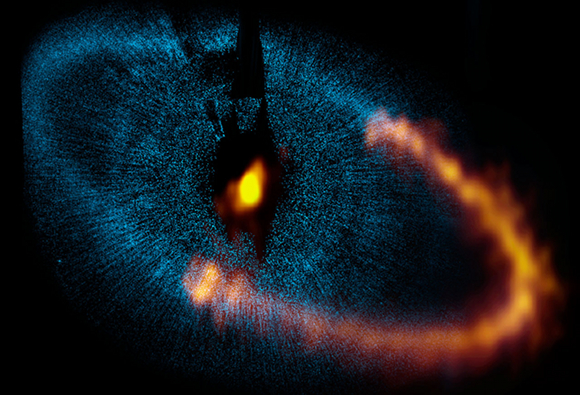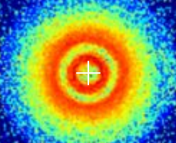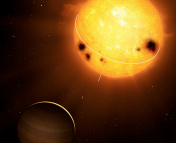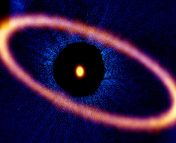TITLE: Constraining the Planetary System of Fomalhaut Using High-Resolution ALMA Observations
AUTHORS: A.C. Boley, M.J. Payne, S. Corder, W. Dent, E.B. Ford, and M. Shabram
FIRST AUTHOR’S INSTITUTION: Department of Astronomy, University of Florida

The improvement in resolution offered by ALMA. Fomalhaut's dust ring appears unresolved as two bright blobs in observations taken in 2003 by the Submillimeter Common-User Bolometer Array (SCUBA). The ALMA data of one side of the dust ring is overlaid in blue. The star is masked in the center. Source: Sky and Telescope Magazine (click image for link)
The first science results from the Atacama Large Millimeter/submillimeter Array (ALMA) have been published! The observations reveal the dust ring encircling the star Fomalhaut with unprecedented resolution (check out the figure to the right). This star, just 25 light years from Earth, has received much attention from planet hunters in recent years, as the star’s exquisite dust ring is believed to be an ideal laboratory for planet formation.
In recent months, the system has been at the center of controversy. For several years, it was believed that the star was home to a Jupiter-like planet, Fomalhaut b, which was first identified in optical images from the Hubble Space Telescope in 2008. However, the planet’s existence was challenged when infrared observations from the Spitzer Space Telescope failed to find the planet. Now, using high-resolution images from ALMA, Boley et al. show that Fomalhaut likely hosts not one but two planets, each with a mass comparable to the mass of the Earth. These planets have not been directly detected by ALMA, but their presence is the most likely explanation for the observed properties of Fomalhaut’s dust ring.
The authors used ALMA’s superlative resolution to determine the morphology of Fomalhaut’s dust ring with unprecedented precision. The new observations confirm that the disk is slightly eccentric and thin like a ring. Located roughly 135 astronomical units from the star, the disk is only 13 to 19 astronomical units wide. The most surprising aspect of the dust ring is that its inner and outer boundaries are extremely sharp. You can see this sharpness for yourself in the figure below.

A composite image showing the dust ring surrounding the star Fomalhaut. The optical image from the Hubble Space Telescope is shown in blue, with ALMA observations in orange. The star at the center has been masked. Source: ALMA: ESO/NAOJ/NRAO; visible light image: NASA/ESA Hubble Space Telescope
The authors propose that two planets, one just inside the ring and one just outside, sculpt the ring’s sharp edges. Through their gravitational interaction with the dust particles in the ring, these ‘shepherd planets’ ensure that the bodies in the ring stay confined to a thin region with sharp cutoffs on either side. This is a well-known astrophysical phenomenon and has even been observed in the F-ring of Saturn and the ε-ring of Uranus.
How exactly do the ‘shepherd planets’ force the dust particles to stay within the ring? There are two well-known facts about objects on Keplerian orbits that can explain this effect. The first is that an object’s orbital speed decreases with increasing distance from the host star; i.e., it takes the Earth longer to go around the Sun than it does Mercury. The second is that an object’s total energy increases with increasing distance from the host star. Now let’s apply these fact to the Fomalhaut system. The planet that orbits just inside Fomalhaut’s ring will be moving faster than the particles that are actually in the ring. The gravity of the faster-moving planet will tend to pull on the objects in the ring, causing them to move faster and gain energy. As the dust particles gain energy, they must move to a larger orbital radius. The opposite is true for the planet orbiting just outside the dust ring. This planet moves more slowly than the objects in the ring so its gravity will drag the particles back, causing them to lose energy and move to a smaller orbital radius. Voilà, the dust particles are confined to the ring!
The authors use simulations to determine what combination of planet masses best reproduces the observed properties of Fomalhaut’s dust ring. They find that both planets must have masses less than three times the mass of the Earth. The combination of masses that provides the best fit to the data is one planet with a mass similar to that of Mars and one planet with a mass a few times that of the Earth. Orbiting at roughly three and a half times the distance between the Sun and Pluto, these planets are likely to be extremely cold.
Could one of these planets be the infamous Fomalhaut b, that was discovered by the Hubble Space Telescope in 2008? It is possible that the planet just inside the ring could be the same object detected in the Hubble images. However, models used by Boley et al. indicate a discrepancy of roughly 10 astronomical units between the orbital radii of the supposed Fomalhaut b and the inner shepherd planet. But remember, while the ALMA results strongly suggest the existence of two planets, the authors do not directly detect the actual objects. The controversy surrounding Fomalhaut will likely persist until the day when its planets can be directly detected in an image. Given the low masses of the inferred planets and the large distance between the planets and their host star, this will prove to be a difficult observational feat and will likely require the next generation of telescopes (i.e., the Thirty Meter Telescope, the European Extremely Large Telescope, etc). Nevertheless, planned future observations of Fomalhaut with ALMA and the Hubble Space Telescope should continue to unravel the mysteries of this planetary system.
For a firsthand account of the inner workings of ALMA, be sure to check out these postings from Astrobites own Adele Plunkett.





Exciting results, and great post!!